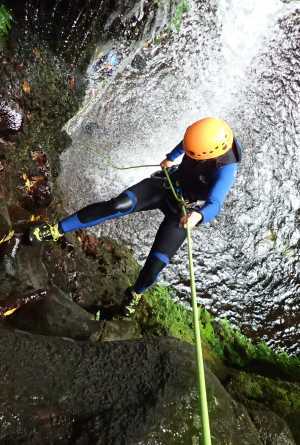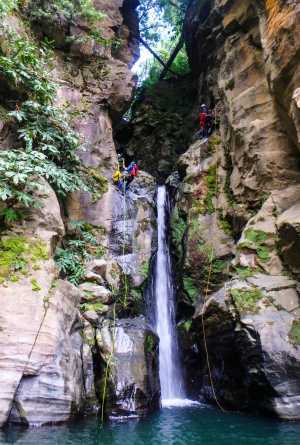I probably should have read my itinerary more carefully. I didn’t know we were going canyoning until dinner the night before, when the other journalists in my group started discussing the best way to bow out of this pre-planned activity. I feigned prior knowledge of the adventure while fumbling to pull up our itinerary on my phone. Sure enough, canyoning had been on it all along, right above the significantly more innocuous item: “visit hot springs.”
Getting There
Azores Airlines offers direct flights from Toronto to Sao Miguel’s capital, Ponta Delgada. Flights depart three times per week, with round-trip prices starting as low as $570. Azores Adventure Islands offers half and full day canyoning excursions.
Now I’m standing behind the open back doors of a minivan in the parking lot of Ribeira dos Caldeirões, a park in the northeastern corner of Sao Miguel Island in the Azores. I’m struggling to pull two skin-tight layers of wetsuit over my thighs, feeling not unlike a human version of meat being stuffed into sausage casing, and wishing I had passed on the third glass of wine at the aforementioned dinner.
Only one member of my five-person group is battling beside me with her own wetsuit layers – the others are fully-clothed and smiling at us with faces that are encouraging but also reflect the relief they feel for already requesting an alternative activity for the morning. I suppose it would be easy for me to change my mind about canyoning and join the majority of my group in skipping it. But thanks to some combination of FOMO, and guilt about a tour planned for five people ending up as a tour for one person, I’m determined to go through with it.
And after all, adventure is what the Azores are all about. A group of nine volcanic islands in the middle of the Atlantic Ocean, the Azores are being dubbed as the “next Iceland” by many travellers thanks to their position between North America and Europe, which makes them an appealing destination for trans-Atlantic stopovers. Others describe the islands as “Europe’s Hawaii” for their unspoiled landscapes. Volcanoes, dense forests, thermal pools and green pastures are just the beginning of the wonders that make the Azores a growing hotspot for travellers to try everything from cycling around craters to, as I’m about to discover, canyoning through ravines.
There’s no turning back once I zip up the wetsuit, my fate sealed as the rubber seals to my body. I look up at my guide: “Non-adventurous people do this all the time right?” I ask. “Of course,” he says with a smile. We set off along a tree-lined path into the interior of the park. We’re walking uphill, making our way to the high point of the trail, so we can navigate back to our starting point by following the canyon down through a series of waterfalls. I soon realize that walking, particularly uphill, is more challenging with the added bulk of the wetsuit. “This is a lot harder with the wetsuit on,” says Catherine, the only group mate who decided to take on the canyoning challenge with me. But she doesn’t seem to be huffing and puffing as much as I am.
Our guide is talking about the Azores as we walk and I try to focus on what he’s saying instead of the growing sense of claustrophobia welling up within me, the wetsuit feeling like a full-body noose that tightens with each step. The Azores are politically part of Portugal – Portuguese is the local language and the currency is euros – but with Lisbon located over 1,446 kilometres away, the islands have developed their own distinctive culture over the centuries and each is known for something a little different.
Pico, for example, is famous for its volcanic vineyards, while Terceira is home to the UNESCO-listed Angra do Heroísmo, the oldest town in the archipelago. As a result, you haven’t really seen the Azores until you’ve hopped between several islands. Sao Miguel Island, where we’re currently trekking, is the largest and most developed island, but particularly now in the low season, it feels rugged and remote.
The rope slides through my nervous fingers and he plunges into the water
Sunlight seeps through the dewy plant-life surrounding us as we wade into a shallow, rocky canyon. Our guide tells us that the majority of canyoning-related injuries happen not from repelling down waterfalls, as you might expect, but from tripping over hidden rocks in streams like this one. He assures us, though, that no accidents have happened with this particular tour company in over 12 years. “Don’t ruin my record,” he says with a wink.
Before we begin our descent down the canyon, our guide demonstrates some basic rappelling techniques on a low rock wall at the edge of the river. Rappelling (a term I would later Google) is a controlled descent down a rock with the use of ropes. He loops thick climbing ropes through his harness and secures everything with a series of knots and metal clips.
He shows us how to position our feet against the rock so we can walk down while positioned perpendicular to the face, releasing the rope as we descend to gradually lower ourselves. He asks me to practice lowering him down the wall, so I can get a feeling for how to control the rope. “Which hand do you belay with?” he asks and passes the rope to me. “I...don’t belay,” I say. He positions himself on the wall and tells me to release the rope slightly. Too much rope slides through my nervous fingers and he plunges into the water.
Despite me having ostensibly failed the test run, we’re moving on to our first descent. It’s a thin but powerful waterfall that tumbles about three metres down a concave rockface. As I sway unevenly, making my way down the rock, I’m reminded of the firepole scene in Bridget Jones’s Diary and decide that it’s a fair approximation of how graceful I look at the moment.
A few descents later, I’m starting to get the hang of it – or at least feel more confident that if I lose control, our guide will just take over the ropes and lower me down manually, like transporting a sack of goods in an old-fashioned dumbwaiter. At our next descent, however, I’m introduced to a new component of canyoning: Waterfall jumping.
Leaping off a waterfall into a river requires none of the technical skill of rappelling (a point in its favour), but as I step up to the edge, I realize that what waterfall jumping lacks in difficulty, it makes up for in terrifyingness. It doesn’t occur to me until I’m in the water that if the wetsuit weighed me down on land, it would certainly weigh me down underwater too. The heavy wetsuit pulls me deeper into the river water than I expect and my frantic upward strokes are slow to propel me back to the surface.
We’re out of the river now, walking on the trail again and the warm sun is starting to dry my wetsuit. We round a corner and I see my group mates waving to us from the upper ledge of the canyon. We’ve returned to our starting point and I’m feeling pretty self-congratulatory now that it’s over, mentally patting myself on the back for overcoming my fears. It had actually been kind of fun.
“Ok, we call this last part ‘jump jump,’” says our guide. We’re not done. I take back every thought I just had about this being fun. “Jump jump” turns out to be a three-metre waterfall jump, followed by a five-metre one. I hesitate at the top of the three-metre jump, staring down at the reflection of the leaves in the water and thinking about how insanely far three metres feels when you’re about to fall down that distance.
The last jump, we discover, is optional. There’s a short path we can follow if we want to bypass the waterfall instead. No fuss, no muss. I feel like our guide is mostly directing this alternative at me, which is understandable given that I’ve been more tentative throughout this trek than my bolder companion. However, his well-intentioned doubt provokes a stubborn determination in me. I am so doing this.
“You can’t think about it. Just Jump!” our guide yells from the bottom. so I do.
Catherine walks up to the waterfall edge first, as she has every time so far. She braces for the jump and then looks down. She steps back. She’s barely finished asking me if I want to go first before I’m rocketing into the air, knowing I’m going to lose my courage if I stop for even a second. Five metres is a long fall, long enough that I notice the feeling of being airborne before I hit the water.
Back at the van, we strip off our wetsuits, which are much easier to get off than on now that they’re soaking wet. I didn’t think to bring a towel, so I slide my dry clothes, warm from sitting in the sun-drenched van, over my damp skin. We reunite with our group mates and pile back into the van. Our next stop is Furnas, a lakeside spot known for its geysers and thermal pools. It’s the “hot springs” part of today’s itinerary that I had been prepared for all along.
As we drive, I gaze at the cows grazing on the sloping green meadows, looking as though they’ve consciously distributed themselves to create a bucolic scene; at the clusters of azaleas and hydrangeas fringing the road; and at the ocean, which occasionally reveals itself through gaps in the terrain. It’s a wild, beautiful landscape that stirs a sense of adventure – even in non-adventurous people.


